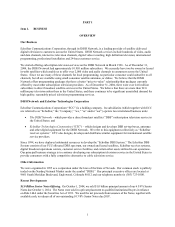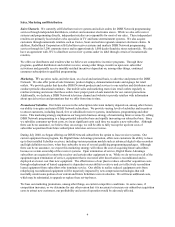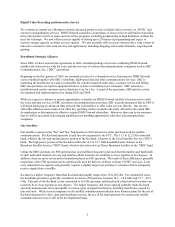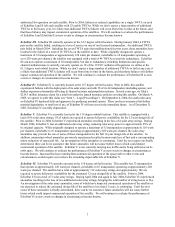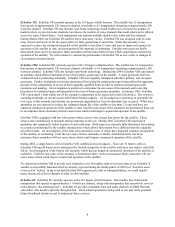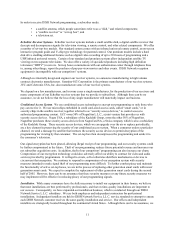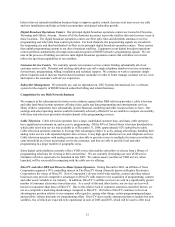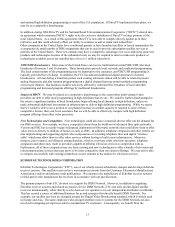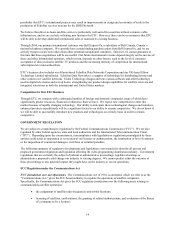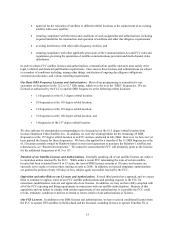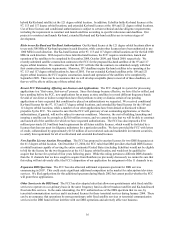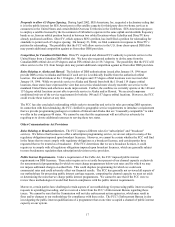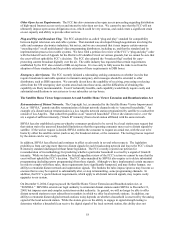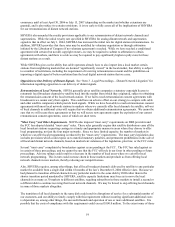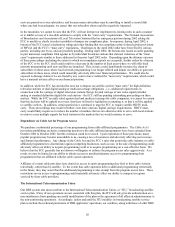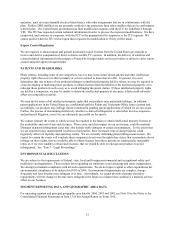Dish Network 2004 Annual Report Download - page 19
Download and view the complete annual report
Please find page 19 of the 2004 Dish Network annual report below. You can navigate through the pages in the report by either clicking on the pages listed below, or by using the keyword search tool below to find specific information within the annual report.11
In order to receive DISH Network programming, a subscriber needs:
• a satellite antenna, which people sometimes refer to as a “dish,” and related components;
• a “satellite receiver” or “set-top box”; and
• a television set.
EchoStar Receiver Systems. EchoStar receiver systems include a small satellite dish, a digital satellite receiver that
decrypts and decompresses signals for television viewing, a remote control, and other related components. We offer
a number of set-top box models. Our standard system comes with an infrared universal remote control, an on-screen
interactive program guide and V-chip type technology for parental control. Our premium models include a hard
disk drive enabling additional features such as digital video recording of up to 210 hours of programming and a
UHF/infrared universal remote. Certain of our standard and premium systems allow independent satellite TV
viewing on two separate televisions. We also offer a variety of specialized products including high definition
television (“HDTV”) receivers. Set-top boxes communicate with our authorization center through telephone lines
to, among other things, report the purchase of pay-per-view movies and other events. DISH Network reception
equipment is incompatible with our competitors’ systems.
Although we internally design and engineer our receiver systems, we outsource manufacturing to high-volume
contract electronics manufacturers. Sanmina-SCI Corporation is the primary manufacturer of our receiver systems.
JVC and Celetronix USA, Inc. also manufacture some of our receiver systems.
We depend on a few manufacturers, and in some cases a single manufacturer, for the production of our receivers and
many components of our EchoStar receiver systems that we provide to subscribers. Although there can be no
assurance, we do not believe that the loss of any single manufacturer will materially impact our business.
Conditional Access System. We use conditional access technology to encrypt our programming so only those who
pay can receive it. We use microchips embedded in credit card-sized access cards, called “smart cards,” or in
security chips in the satellite receiver, together referred to as “security access devices,” to control access to
authorized programming content. ECC owns 50% of NagraStar L.L.C., a joint venture that provides us with
security access devices. Nagra USA, a subsidiary of the Kudelski Group, owns the other 50% of NagraStar.
NagraStar purchases these security access devices from NagraCard SA, a Swiss company which is also a subsidiary
of the Kudelski Group. These security access devices, which we can upgrade over the air or replace periodically,
are a key element in preserving the security of our conditional access system. When a consumer orders a particular
channel, we send a message by satellite that instructs the security access devices to permit decryption of the
programming for viewing by that consumer. The set-top box then decompresses the programming and sends it to
the consumer’s television.
Our signal encryption has been pirated, allowing illegal receipt of our programming, and our security systems could
be further compromised in the future. Theft of our programming reduces future potential revenue and increases our
net subscriber acquisition costs. In addition, theft of our competitors’ programming can also increase our churn.
Compromises of our encryption technology could also adversely affect our ability to contract for video and audio
services provided by programmers. It is illegal to create, sell or otherwise distribute mechanisms or devices to
circumvent that encryption. We continue to respond to compromises of our encryption system with security
measures intended to make signal theft of our programming more difficult. To further combat piracy and maintain
the functionality of active set-top boxes, we are in the process of replacing older generation smart cards with newer
generation smart cards. We expect to complete the replacement of older generation smart cards during the second
half of 2005. However, there can be no assurance that these security measures or any future security measures we
may implement will be effective in reducing piracy of our programming signals.
Installation. While many consumers have the skills necessary to install our equipment in their homes, we believe
that most installations are best performed by professionals, and that on time, quality installations are important to
our success. Consequently, we have expanded our installation business, which is conducted through our DISH
Network Service L.L.C. subsidiary. We use both employees and independent contractors for professional
installations. Independent installers are held to DISH Network Service L.L.C. service standards to attempt to ensure
each DISH Network customer receives the same quality installation and service. Our offices and independent
installers are strategically located throughout the continental United States. Although there can be no assurance, we


